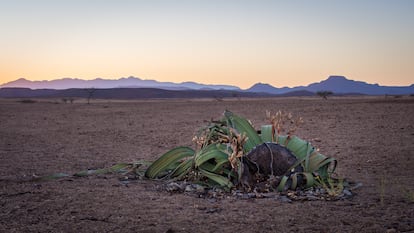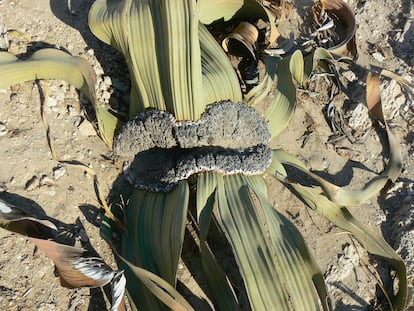Welwitschia: genetics unveil the secrets of the immortal plant
The species is native to Namibia and Angola and can live for thousands of years in extreme environmental conditions due to its duplicated genome

When Joseph Dalton Hooker, director of the Kew Royal Botanical Gardens in London between 1865 and 1885, first cast his gaze on an example of Welwitschia he could not contain himself: “It is without question the most wonderful plant ever brought to this country, and one of the ugliest.” This species, Welwitschia mirabilis, was first formally described in 1863 and has been the subject of debate ever since it was first discovered. It has been established that it can survive for thousands of years in the harshest environments, making it the longest-living plant on the planet. But a recent genetic analysis published in Nature Communications has revealed new data about this curious plant species. Welwitschia’s duplicated genome means that some of its genes can dedicate themselves to tasks that are not part of their original functions. Furthermore, this species can activate certain proteins to protect itself from the extreme conditions in which it lives and it grows slowly but continuously throughout its entire life.
Welwitschia is found in Namibia’s northwest and southeastern Angola, an area dominated by the Kaokoveld Desert. Despite being geographically near to the coast, this region is arid and annual rainfall is less than five cubic centimeters. The plant’s appearance is also distinctive, consisting of two foliage leaves that can grow by 10 to 13 centimeters each year. As they grow, the tips of the leaves dry out and curl together, which sometimes lends the plant an appearance similar to an octopus.

Genome analysis of Welwitschia has shown that all of its genes are duplicated, what experts describe as “genetic redundancy.” Andrew Leitch, a researcher at the Queen Mary University of London and one of the authors of the study, explains how this duplicity, over the course of millions of years, has altered the functioning of these genes: “The duplicated copies can take on new functions and do new things that would be impossible if there was only one version of the gene. These adaptations have driven the evolution of the plants.” For example, the researchers believe that the leaves are capable of absorbing some of the humidity from clouds of mist that form in the plant’s natural habitat when dawn breaks.
Welwitschia’s genetic duplication began around 86 million years ago and was prompted by the stress placed on the plants by being constantly exposed to some of the harshest environmental conditions on the planet (high temperatures, ultraviolet radiation, salinity and so forth). In the face of this constant assault, Welwitschia always maintains a variety of proteins overactivated that allow the plant to keep these environmental stress factors at bay. Leitch explains it with a culinary example: “When you put an egg in boiling water, the proteins in the egg are denatured and the white of the egg hardens. This denaturalization is a problem for the plants and animals that live in conditions of extreme heat and Welwitschia activates certain genes to prevent this from happening.”
Identifying genes that allow for survival in hostile conditions will be useful when we are looking to grow crops in ever more marginal areas of the planetAndrew Leitch, researcher at the Queen Mary University of London
Furthermore, unlike other plants, Welwitschia’s growth does not occur at the tips of the leaves but at the base. This area of the plant is heavily protected by two lips consisting of a woody fiber that cover the basal meristem, the part of the plant that supplies new cells. This type of bulb is formed of a practically embryonic tissue, still poorly defined, that gradually transforms into leaf tissue at a very slow pace. While this bulb lives, the plant will never stop growing. As such, the name given to it in Afrikaans is tweeblaarkanniedood, which literally translates as“two leaves that cannot die.” The plants can live to such an age that the researchers had to use carbon-dating technology usually reserved for fossils to determine how old their subjects were. The results confirmed that some individuals were more than 1,500 years old.
Leitch believes that this discovery could prove to be key in the medium- to long-term for the survival of the human race. “Identifying genes that allow for survival in hostile conditions will be useful when we are looking to grow crops in ever more marginal areas of the planet, something that we will have to do to be able to feed the nine billion people that we will be within the next 50 years with a high-level diet, as well as finding space for bio-combustibles. And all of that has to be achieved in a context of climate change and alterations in rainfall and temperature.”
Alfonso Blázquez, a professor and researcher at the Autonomous University of Madrid who did not take part in the study, harbors doubt over the viability of this potential application. “Overexpressing one or two genes in commercial crops is unlikely to achieve the same effect, because this plant has a battery of protective genes activated at the same time, but they may obtain some kind of greater resistance to heat or a lack of humidity. This could be an intermediate application that should be investigated.”
English version by Rob Train.
Tu suscripción se está usando en otro dispositivo
¿Quieres añadir otro usuario a tu suscripción?
Si continúas leyendo en este dispositivo, no se podrá leer en el otro.
FlechaTu suscripción se está usando en otro dispositivo y solo puedes acceder a EL PAÍS desde un dispositivo a la vez.
Si quieres compartir tu cuenta, cambia tu suscripción a la modalidad Premium, así podrás añadir otro usuario. Cada uno accederá con su propia cuenta de email, lo que os permitirá personalizar vuestra experiencia en EL PAÍS.
¿Tienes una suscripción de empresa? Accede aquí para contratar más cuentas.
En el caso de no saber quién está usando tu cuenta, te recomendamos cambiar tu contraseña aquí.
Si decides continuar compartiendo tu cuenta, este mensaje se mostrará en tu dispositivo y en el de la otra persona que está usando tu cuenta de forma indefinida, afectando a tu experiencia de lectura. Puedes consultar aquí los términos y condiciones de la suscripción digital.
More information
Archived In
Últimas noticias
Most viewed
- Sinaloa Cartel war is taking its toll on Los Chapitos
- Reinhard Genzel, Nobel laureate in physics: ‘One-minute videos will never give you the truth’
- Oona Chaplin: ‘I told James Cameron that I was living in a treehouse and starting a permaculture project with a friend’
- Why the price of coffee has skyrocketed: from Brazilian plantations to specialty coffee houses
- David King, chemist: ‘There are scientists studying how to cool the planet; nobody should stop these experiments from happening’










































